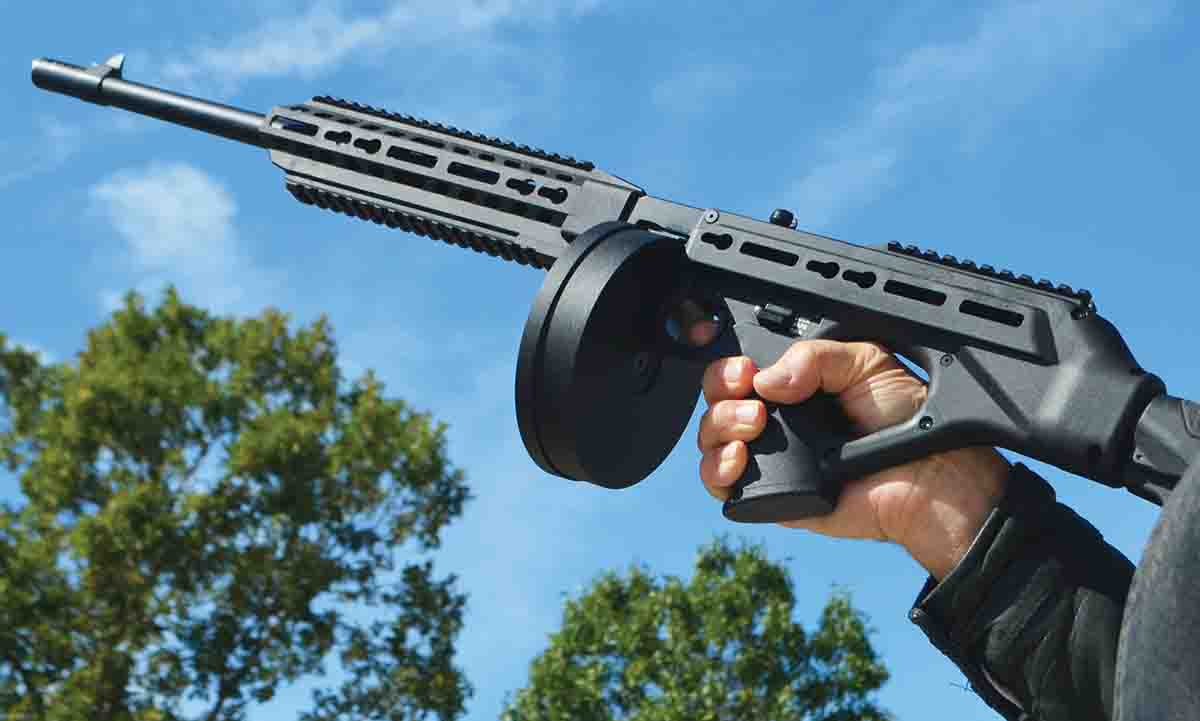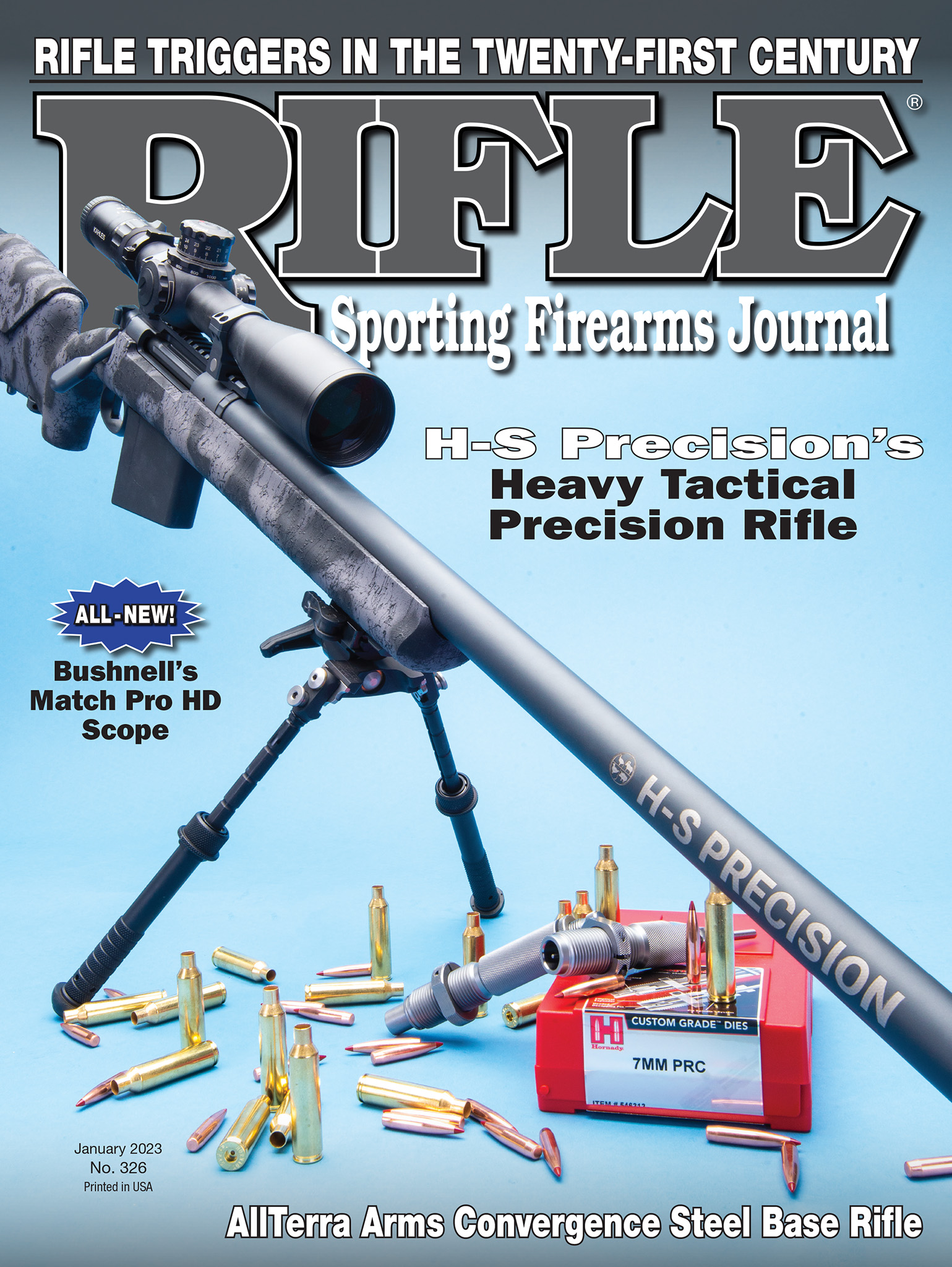Walnut Hill
Son of Tommy
column By: Terry Wieland | January, 23

With its double-pistol grip, radial fins on the barrel, and, perhaps most of all, its 100-round drum magazine, the “tommy gun” (as it quickly became known) was the emblem of much that was good, but a whole lot that was bad, about America in the early twentieth-century.
Patented in 1920, the Thompson, or tommy gun, was almost an emblem for Prohibition-era gang warfare. Two Thompsons were used in the Saint Valentine’s Day Massacre in Chicago in 1929, and George Kelly Barnes – “Machine Gun Kelly” – got his nickname because the tommy gun was his favorite weapon.
So many images are associated with the Thompson that it’s hard to know where to start. There is the enduring image of a gangster carrying a violin case that holds a tommy gun instead of a Stradivarius; and there is its nickname, the “Chicago piano.”
The most historically significant, from an international point of view, is a photograph of Winston Churchill from 1940. He’s dressed in a double-breasted pinstripe suit with fedora and characteristic cigar, holding a Thompson and looking like he just stepped out of a Duesenberg on State Street. The photo was intended to convey Britain’s determination to fight on after everyone else had surrendered; when Adolf Hitler saw it, he insisted it proved Churchill was a gangster, and he referred to it frequently right up until his death. Such was the power of the tommy gun’s image.
I first handled a Thompson when I was 16. A family friend, Dick, who taught me my first handloading, was a Thompson collector, and owned about 250 of them. His two-story brick house had its entire second floor turned into a vault, which contained a Browning machine gun, a water-cooled Colt, a Schmeisser, a Sten, a Sterling and several others I couldn’t identify at the time. Most of Dick’s Thompson collection was stored in a warehouse. Needless to say, his second floor became a house of wonders to me, comparable to the Victoria & Albert.
For those who remember the TV ads from the 1960s, Dick most closely resembled “Mr. Clean” as tall, burly and bald as a billiard ball. He served in the Marines in the Pacific, and during one landing he was attacked by a sword-wielding Japanese soldier. Dick emptied his .30 Carbine into him but it did not do the job, and he was saved by a pal with a bigger gun. Dick immediately set about finding himself a Thompson, which he carried for the duration.
Handling one of his Thompsons, I was immediately consumed by a teenager’s desire to shoot it. Dick promised to take me out to the gravel pit where he did his shooting, but it never came about, and it was many years before I pulled the trigger on one for real. Still, the magic never faded and when Tony Galazan’s Standard Manufacturing (a sister firm to Connecticut Shotgun Manufacturing Company) announced last year that it was going to produce a .22 semiauto with a drum magazine – well, I couldn’t wait to get my hands on one.
There are two common misconceptions about the tommy gun. One is that it was the first submachine gun. It wasn’t. That honor belongs to the Austrian Steyr and various iterations of the German Luger P’08 and Broomhandle Mauser. The second misconception is that Thompson invented the drum magazine; these, too, were earlier used on Lugers, and were called “snail drums” because the drum was attached to a standard Luger clip. Standing by itself, it resembled a snail.
However, the Thompson, which could be had with either a 50- or 100-round drum, is certainly the gun that made the drum magazine famous to the point that seeing a tommy gun with the more common box magazine somehow looks wrong.
The Galazan G4S has been described by some as a “baby tommy gun” and that’s not far wrong. It also incorporates elements of the AR-15 and various lesser known firearms of more recent vintage. All the details can be found on Standard Manufacturing’s website, so we won’t dwell on all the specifications here. Frankly, I’m more interested in how it shoots than I am in what I can attach to it, although the short answer to that is “lots.” The G4S is festooned with Picatinny rails and other attachment points that allow an owner to fasten almost anything but a bayonet.
Suggested retail prices don’t mean a lot, but those for the G4S provide an idea. The rifle itself lists at $549 (or did) with the 50-round drum selling for $249 and the 10-round box for $49. Not cheap for a .22, but not expensive for what you get.
My very first priority when I got the rifle was to see how well the drum magazine functioned. If this suggests my past experience with drums has not been scintillating, you’re right. The Luger snails are difficult to load – I can’t imagine trying to recharge one crouched down in a muddy trench with bullets flying – but once filled, they function pretty well.
The G4S is easy to load, requiring no clockwork-spring levers or anything like that. In spite of the rarity and price of good .22 Long Rifle ammunition last summer, I filled it and emptied it with three different types of ammunition (CCI Mini-Mag, SK High Velocity Target, and Aguila Super) and had a grand total of one failure to feed. This was instantly rectified by simply pushing the breechblock forward by its projecting knob.
Traditionally, or at least according to the movies, the Thompson was in its element being fired from the hip. The G4S is certainly well adapted to this, but it is fitted with a telescoping AR-style buttstock with four settings for length, so it can readily be fired, as a rifle, from the shoulder.
One thing about that first Thompson I remember vividly was its weight, and that was without the drum magazine being fully charged. Of course, for any kind of controlled fire, even the spraying technique we see most often, that weight was required with the hefty recoil of the .45 ACP.
The G4S is considerably lighter; it weighs only 6 pounds fully loaded, compared to 10 pounds, unloaded, for the Thompson. It also has a Cutts Compensator-style muzzle brake, very similar to the Thompson. Needless to say, as fast as I pulled the trigger, recoil was not a factor.
My one real complaint about the G4S is its sights. I think it’s really intended to have a scope or red dot mounted on the Picatinny rail, but I wanted to keep it as close to the Tommy gun as possible. It has a blade front sight, and the shooter aims by aligning it in a long groove running the length of the rail. This works fine, except it’s non-adjustable, and the rifle shot high and to the left.
The answer? Shoot from the hip and watch where the bullets throw up dust and dirt. It worked fine for the boys in that Chicago garage on February 14, 1929.


